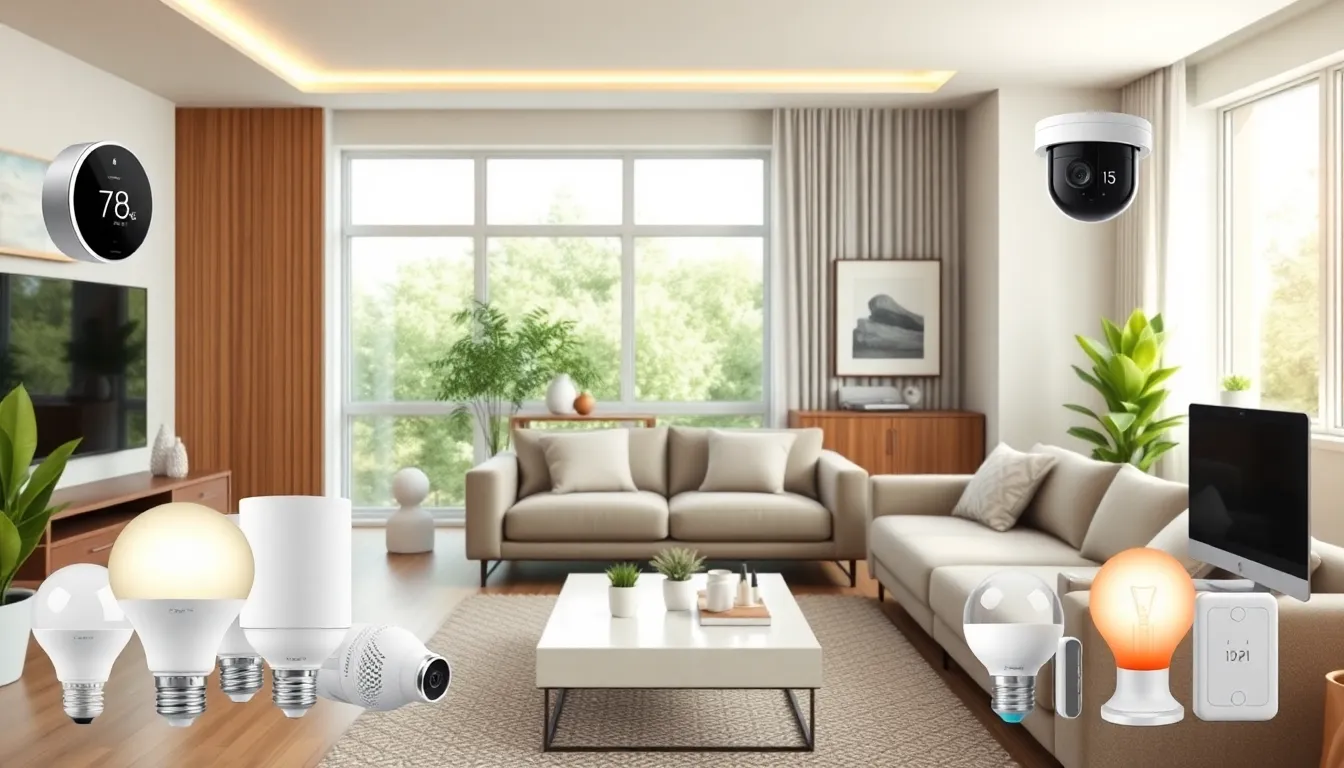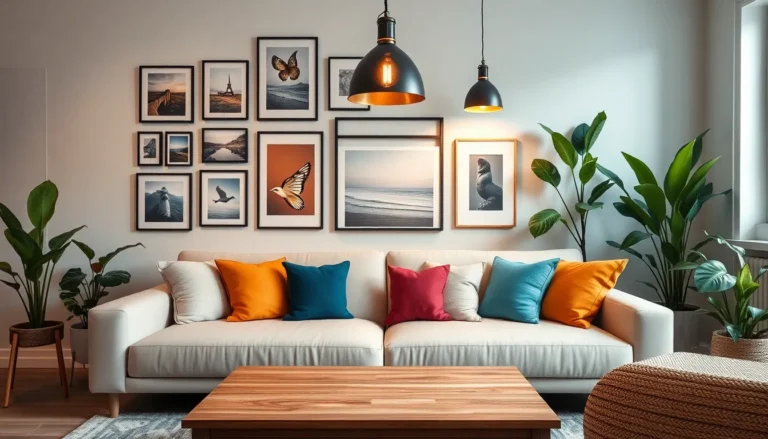Imagine walking into your home and having it greet you like an old friend. Lights flick on, your favorite music starts playing, and the thermostat adjusts to your ideal temperature—all without lifting a finger. Welcome to the world of home automation design, where technology transforms everyday living into a seamless experience.
In this tech-savvy age, it’s not just about convenience; it’s about creating a space that thinks for you. Whether you’re a gadget guru or just someone who wants to impress their in-laws, home automation can elevate your living environment to a whole new level. Say goodbye to fumbling for light switches and hello to a home that’s as smart as you are! Let’s dive into the essentials of designing a home that practically runs itself—because who wouldn’t want a personal assistant that doesn’t need coffee breaks?
Table of Contents
ToggleOverview of Home Automation Design
Home automation design utilizes smart technology to improve living environments through responsive systems. This design prioritizes convenience, enabling users to control various aspects of their homes, such as lighting, climate, and security, from mobile devices or voice commands. Integrating devices seamlessly creates an ecosystem that adapts to individual lifestyles.
Smart lighting systems allow homeowners to set schedules or adjust brightness through an app. Climate control systems maintain desired temperatures, optimizing energy efficiency based on preferences. Security features, including cameras and alarm systems, enhance safety while providing real-time alerts to users.
Home automation can accommodate various devices. Smart thermostats learn usage patterns to suggest optimal heating or cooling settings. Wireless speakers can provide music throughout the house, responding to voice commands to create an immersive audio experience. Smart locks offer secure access, allowing users to grant entry remotely.
Accessibility plays a crucial role in home automation design. Voice recognition and mobile applications ensure users of all ages interact effortlessly with technology. Customization options allow tailored solutions, accommodating specific needs and preferences.
Scalability is another essential aspect. Home automation systems can expand over time, integrating new devices as technology advances. This flexibility ensures that homes remain updated and functional without extensive renovations.
During the planning phase, considerations like network infrastructure and power supply significantly influence system effectiveness. Assessing the layout helps optimize device placement for enhanced coverage and performance. Incorporating reliable connectivity ensures smooth operation across all automated features, maximizing the user experience.
Key Components of Home Automation

Home automation design incorporates various essential elements that work together to create a cohesive, smart living environment. Understanding these components enhances the overall effectiveness and enjoyment of automated systems.
Smart Devices
Smart devices play a crucial role in home automation. They come in various forms, including smart bulbs, thermostats, cameras, and voice assistants. Each device contributes unique functionalities, such as adjusting temperature, monitoring security, or controlling lighting. The integration of devices ensures seamless operation throughout the home. For example, smart lighting systems can be programmed to change brightness based on time of day or specific activities. Users access these devices through mobile apps or voice commands, enabling convenient control from anywhere within or outside the home.
Communication Protocols
Communication protocols form the backbone of home automation systems. These protocols facilitate data exchange between devices, ensuring they work harmoniously. Popular protocols such as Wi-Fi, Zigbee, and Z-Wave offer distinctive advantages. Wi-Fi allows for high-speed connectivity, while Zigbee and Z-Wave specialize in low-power communication, ideal for battery-operated devices. Compatibility with multiple protocols enhances the flexibility of the system. An efficient network infrastructure maximizes device performance. Users can expand their systems without being limited by incompatibility, resulting in a scalable and adaptable home automation experience.
Planning Your Home Automation Design
Effective planning is crucial for creating an efficient home automation design. Assessing individual needs and setting a budget are key steps to ensure a smooth implementation.
Assessing Your Needs
Identifying priorities shapes the home automation design process. Consider factors such as convenience, security, and energy efficiency to tailor the system appropriately. Homeowners may want smart lighting for ambiance or advanced security systems for peace of mind. Engaging family members in the decision-making process ensures each person’s needs are met. Understanding the layout and functionality of each room also influences device selection. As a result, users can create a balanced environment that enhances daily living.
Budget Considerations
Establishing a budget guides the selection of devices and technologies. Homeowners should start by determining how much they’re willing to invest in their automation setup. Listing required features helps in allocating funds efficiently. Advanced systems may require a higher budget, yet basic setups can still provide significant convenience. Additionally, considering installation costs alongside device prices ensures comprehensive financial planning. Finally, homeowners should stay informed about long-term savings potential through energy-efficient solutions. This approach ultimately leads to a successful home automation project tailored to individual financial circumstances.
Implementing Home Automation Design
Implementing home automation design involves thoughtful choices about installation and integration to achieve an effective smart environment.
Installation Options
Wiring options for devices can make a significant difference in setup. Homeowners often choose between structured wiring or wireless systems based on their existing infrastructure. Structured wiring provides a stable connection and optimal performance for many smart devices. Wireless systems, on the other hand, offer flexibility by allowing easy placement of gadgets without the need for extensive renovations. Including multiple rooms during installation enhances the user experience by creating a seamless environment throughout the home. New homeowners might also consider professional installation for complex setups, ensuring everything functions correctly from the start.
Integration with Existing Systems
Integration into existing systems is crucial for maximizing home automation effectiveness. Smart home devices often come with compatibility features that allow them to work with other technologies already in place. They may interface with security systems, lighting, and climate controls to create a unified control experience. Connecting devices can enable users to manage their homes through a single app or voice command, significantly simplifying daily tasks. Choosing products that support multiple communication protocols ensures smooth integration. Homeowners should evaluate their current systems before purchasing new devices to ensure compatibility and functionality.
Future Trends in Home Automation Design
Artificial intelligence plays a substantial role in the evolution of home automation design. It enhances personalized experiences through machine learning, enabling systems to adapt to user preferences over time. Smart assistants streamline daily tasks, from adjusting schedules to providing reminders.
Energy efficiency remains a priority as technologies advance. Smart appliances optimize power usage, leading to cost savings and sustainability. Examples include refrigerators that manage grocery inventories and thermostats that adjust heating based on occupancy.
Integration of health monitoring systems is increasingly common. Devices track air quality, temperature, and humidity, promoting a healthier living environment. Wearable health technology can sync with home systems, alerting users to potential issues.
User interface improvements foster greater accessibility. Control panels become more intuitive, ensuring seamless interaction with various devices. Voice commands gain prevalence, allowing hands-free management of smart homes.
Security advances also take center stage. Enhanced surveillance cameras and motion sensors provide real-time alerts, bolstering home safety. Smart locks offer convenient remote access, allowing users to manage entry points from anywhere.
Wireless connectivity continues to evolve, providing faster and more reliable service. Wi-Fi 6 and 5G networks facilitate a stable connection among multiple devices. Smart homes benefit from reduced latency, ensuring responsive interactions between systems.
Customization options expand as manufacturers recognize diverse consumer needs. Homeowners can select from a broad range of devices tailored to their specific requirements. Packages that suit different budgets promote a wider adoption of automation technology.
With these trends shaping the future, home automation design is poised for significant growth. Embracing these innovations becomes crucial for homeowners seeking enhanced lifestyle experiences.
Home automation design is transforming the way people live by seamlessly integrating technology into daily routines. With smart devices enhancing convenience and efficiency homeowners can create environments that truly cater to their needs. The ability to control lighting climate and security through intuitive systems not only elevates comfort but also adds a touch of sophistication to any living space.
As technology continues to evolve the possibilities for customization and scalability in home automation are expanding. This ensures that homeowners can adapt their systems over time while enjoying enhanced safety and energy efficiency. Embracing these innovations allows individuals to experience a new level of living that is both responsive and personalized.






